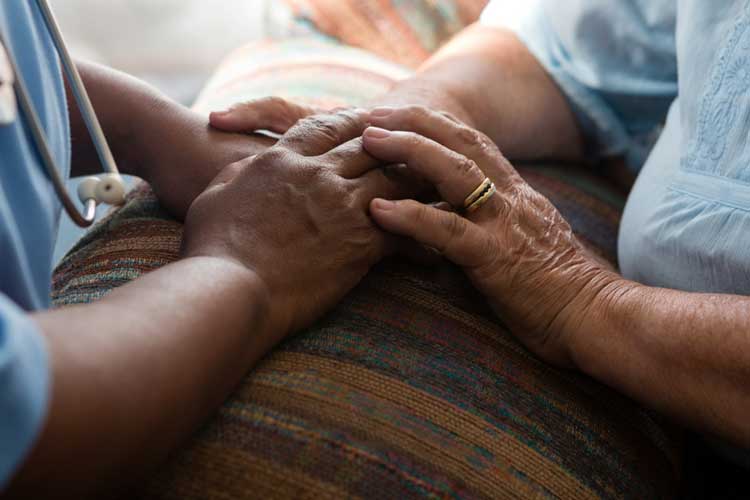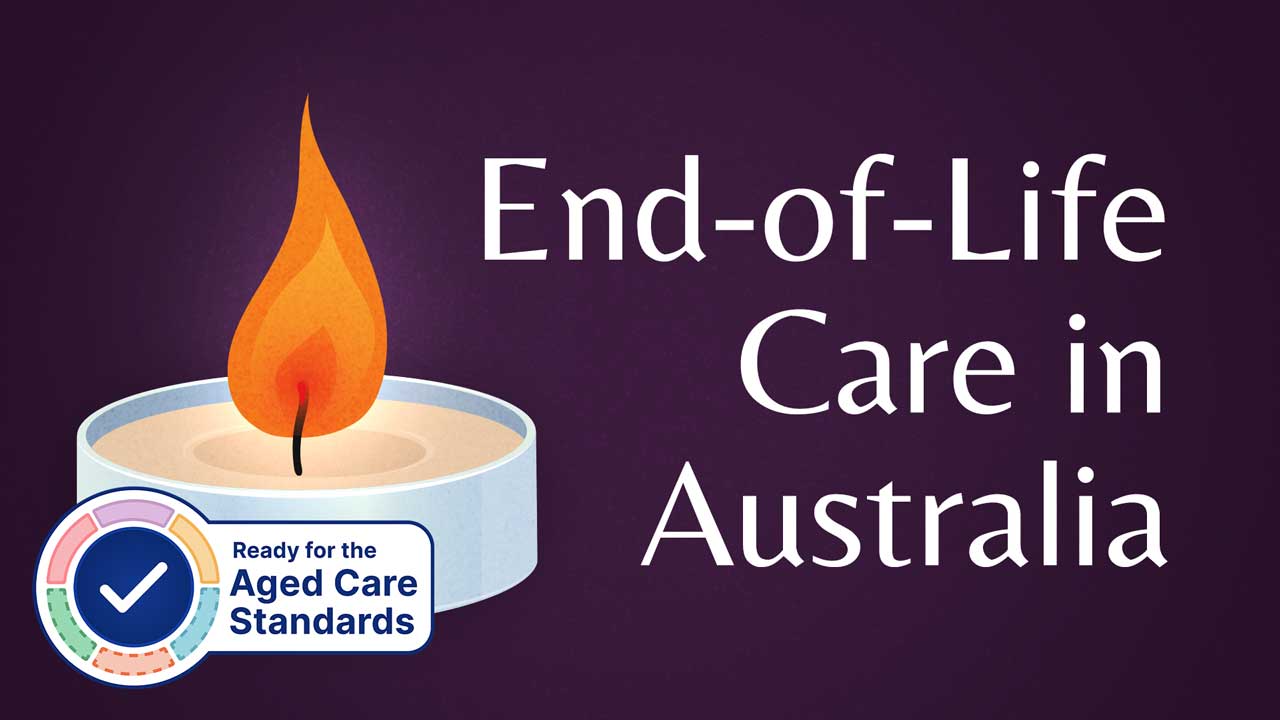The significance of being able to provide compassionate care that eases the suffering of people in their last days cannot be overstated.
When an illness is deemed incurable, an individual has reached the point of ‘end-of-life’. End-of-life care is the support available to terminally ill patients when they find themselves at the final stage of their lives.
End-of-life care aims to improve the quality of life of someone with a life-limiting illness by offering services, information, advice, referral and support (Better Health Channel 2017).
What is the Difference Between End-of-life Care and Palliative Care?
End-of-life care is distinct from palliative care, though they are frequently grouped together.
- End-of-life care may be more distinctively defined as care provided to a person with an incurable illness or whose death is imminent, typically during the final 12 months of their life.
- Palliative care is just one aspect of end-of-life care, intended to assist and support individuals who are living with a considerably limiting illness. This care may be more sporadic and less easily contained in a strict time frame.
(AIHW 2016)
Healthcare professionals are uniquely placed to provide treatment of an emotional, physical, spiritual and psychological nature to patients who require end-of-life care.
Not only does end-of-life care support an individual who is nearing death, but it also caters for family and carers who are placed in the often challenging position of looking after someone in their final days.
End-of-life Care in Australia

A 2015 study ranked Australia's quality of death second out of 80 countries, based on factors including:
- Affordability
- Palliative care being provided alongside end-of-life care
- Human resources
- Community support
- Quality of care.
(AIHW 2016)
Despite this, there is still room for improvement, as some people who have experienced the end-of-life care system in Australia have found it challenging to navigate for patients and their loved ones, adding stress to an already difficult situation (ACSQHC, as cited in AIHW 2016).
The way in which end-of-life care is provided varies from state to state, and of course, access to relevant services and resources plays a significant role in this. These services and resources include:
- Neonatal units
- Paediatric services
- Public and private acute hospital
- General practices and residential and community aged care services, as well as services designed for and provided to people who require support at home.
(AIHW 2016)
It’s important to note that while 20% of deaths are people under the age of 65, end-of-life services in Australia and improvements to the system are largely geared toward older adults (AIHW 2016).
What Does Successful End-of-life Care Look Like?
Compassion and striving toward a ‘good death’ are crucial.
There are several steps we can take to get closer to achieving this, including:
- Promoting discussion about death and the limits of our current health system on a public level
- Enhancing the amount of planning around end-of-life care
- Providing choices for individuals at the end of their life
- Respecting the autonomy of these individuals
- Allowing people to reach the end of their life in their chosen environment, which tends to favour the home as opposed to hospital settings.
(Swerissen & Duckett 2014; AIHW 2016)
End-of-life Care Under the Strengthened Aged Care Quality Standards
Standard 5: Clinical Care - Outcome 5.7: Palliative and End-of-life care under the strengthened Aged Care Quality Standards requires aged care organisations to:
- Identify when an older person is approaching the end of their life, support them in preparing for this and address their changing needs and preferences
- Support an older person, their loved ones, carers and substitute decision-maker to:
- Engage in conversation about end-of-life planning
- Discuss requesting or declining elements of personal care and life-extending treatments, as well as strategies for addressing temporary acute conditions
- Review advance care planning documents
- Establish processes during an older person’s final days of life to:
- Identify that an older person is approaching the end of their life and adapt promptly to their evolving needs
- Ensure continuous availability and appropriate use of medications for pain and symptom control, including anticipatory medications
- Deliver pressure care, oral hygiene, eye care, and bowel and bladder care
- Identify and manage delirium
- Reduce unnecessary hospital transfers, respecting the person’s end-of-life preferences.
(ACQSC 2024)
Supporting Patients Receiving End-of-Life Care
Being informed that you do not have long left to live is devastating news for anyone. Even in situations where the patient is aware that their illness is progressing, this news can ignite stress and emotional responses from them and their loved ones.
You can help to support patients during this challenging time by:
- Helping them implement an advanced care directive about what medical treatments they may or may not wish to have as part of a broader advanced care plan (if not already in place).
- The patient will have many questions - talking about their situation is one of the best ways to cope.
- Reassuring the patient that when faced with the news of reaching an ‘end-of-life’ stage, they are not alone: there are healthcare professionals, resources and communities available to support them.
- Telling the patient that the care available to them is illness-specific - being in a supportive group of others who are going through, or have a deep understanding of what they are going through, may be enormously helpful.
- Remembering that patients are entitled to sympathetic care, support and information about what to expect at the end-of-life stage.
- Encouraging the patient to connect with family and carers and let their wishes be known and understood.
Supporting Carers

Thoughtfulness and attention to detail are of utmost importance when supporting someone at the end of their life.
Carers must consider financial and estate planning, talking to other family members, treatment options and preparing for the person's absence.
When carers are faced with the difficult situation of caring for someone at the end of their life, let them know that help is available. There is a wide range of resources available to help them through this difficult process and quell feelings of fear and uncertainty.
A carer may be concerned specifically about the everyday tasks that seem unmanageable in the event of looking after someone at the end of their life. There are resources available for this, including assistance for:
- Showering
- Toileting
- Getting the patient safely in and out of bed
- Running errands
- Preparing meals
- Sorting out paperwork
(Cancer Council 2020)
Accessing help at a government and community level allows the carer to be one of many people invested in the care of someone at the end of their life rather than bear sole responsibility for the patient.
A ‘Good Death’
Ultimately, care, dignity and respect are the key factors in providing successful end-of-life care. Remember that this care must also extend to the patient's friends and family.
Death is an unavoidable part of life, but striving towards providing outstanding care for those approaching death (at a rate sooner than the rest of us) is a responsibility we must be brave enough to shoulder.
Test Your Knowledge
Question 1 of 3
What distinguishes end-of-life care from palliative care?
Topics
Further your knowledge





 Free
FreeReferences
- Aged Care Quality and Safety Commission 2024, Standard 5: Clinical Care, Australian Government, viewed 19 June 2024, https://www.health.gov.au/resources/publications/strengthened-aged-care-quality-standards-august-2025?language=en
- Australian Institute of Health and Welfare 2016, Australia’s Health 2016: 6.18 End-of-Life Care, Australian Government, https://www.aihw.gov.au/getmedia/68ed1246-886e-43ff-af35-d52db9a9600c/ah16-6-18-end-of-life-care.pdf.aspx
- Better Health Channel 2017, End of Life and Palliative Care Explained, Better Health Channel, viewed 19 June 2024, https://www.betterhealth.vic.gov.au/health/servicesandsupport/end-of-life-and-palliative-care-explained
- Cancer Council Australia 2023, Facing End of Life: A Guide for People Dying with Cancer, Their Families and Friends, Cancer Council Australia, viewed 19 June 2024, https://www.cancer.org.au/assets/pdf/facing-end-of-life
- Swerissen, H & Duckett, S 2014, Dying Well, Grattan Institute, viewed 19 June 2024, https://grattan.edu.au/report/dying-well/
 New
New 
